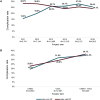Healthcare utilization and costs of cardiopulmonary complications following cardiac surgery in the United States
- PMID: 31856265
- PMCID: PMC6922411
- DOI: 10.1371/journal.pone.0226750
Healthcare utilization and costs of cardiopulmonary complications following cardiac surgery in the United States
Abstract
Purpose: This study examined postoperative heart failure (HF) and respiratory failure (RF) complications and related healthcare utilization for one year following cardiac surgery.
Methods: This study identified adult patients undergoing isolated coronary artery bypass graft (CABG) and/or valve procedures from the Cerner Health Facts® database. It included patients experiencing postoperative HF or RF complications. We quantified healthcare utilization using the frequency of inpatient admissions, emergency department (ED) visits with or without hospital admission, and outpatient visits. We then determined direct hospital costs from the determined healthcare utilization. We analyzed trends over time for both HF and RF and evaluated the association between surgery type and HF complication.
Results: Of 10,298 patients with HF complications, 1,714 patients (16.6%) developed persistent HF; of the 10,385 RF patients, 175 (1.7%) developed persistent RF. Healthcare utilization for those with persistent complications over the one-year period following index hospital discharge comprised an average number of the following visit types: Inpatient (1.49 HF; 1.55 RF), Outpatient (2.02, 0.51), ED without hospital admission (0.33, 0.13), ED + Inpatient (0.08, 0.06). Per patient annual costs related to persistent complications of HF and RF were $20,857 and $30,745, respectively. There was a significant association between cardiac surgical type and the incidence of HF, with risk for isolated valve procedures (adjusted OR 2.60; 95% CI: 2.35-2.88) and CABG + valve procedures (adjusted OR 2.38; 95% CI: 2.17-2.61) exceeding risk for isolated CABG procedures.
Conclusions: This study demonstrates that HF and RF complication rates post cardiac surgery are substantial, and complication-related healthcare utilization over the first year following surgery results in significant incremental costs. Given the need for both payers and providers to focus on healthcare cost reduction, this study fills an important gap in quantifying the mid-term economic impact of postoperative cardiac surgical complications.
Conflict of interest statement
This work was supported financially by Edwards Lifesciences. MS is an employee of Edwards Lifesciences. ADS works as a consultant for Edwards Lifesciences. SHM works as a consultant and AVS, BLAG, XZ, and HOY as employees, for Boston Strategic Partners, Inc., who received funds from Edwards Lifesciences to perform the research. This does not alter our adherence to PLOS ONE policies on sharing data and materials. The data that support the findings of this study are available as the Cerner Health Facts® database from the Cerner Corporation, which is available to the public through licensure with Cerner Corporation.
Figures



Similar articles
-
Quantifying the incremental cost of complications associated with mitral valve surgery in the United States.J Thorac Cardiovasc Surg. 2012 Apr;143(4):864-72. doi: 10.1016/j.jtcvs.2012.01.032. J Thorac Cardiovasc Surg. 2012. PMID: 22424521
-
Predictors and early and late outcomes of respiratory failure in contemporary cardiac surgery.Chest. 2008 Mar;133(3):713-21. doi: 10.1378/chest.07-1028. Epub 2008 Feb 8. Chest. 2008. PMID: 18263692
-
Logistic risk model predicting postoperative respiratory failure in patients undergoing valve surgery.Eur J Cardiothorac Surg. 2008 Nov;34(5):953-9. doi: 10.1016/j.ejcts.2008.07.061. Epub 2008 Oct 2. Eur J Cardiothorac Surg. 2008. PMID: 18835184
-
Impact of bleeding complications on length of stay and critical care utilization in cardiac surgery patients in England.J Cardiothorac Surg. 2019 Apr 2;14(1):64. doi: 10.1186/s13019-019-0881-3. J Cardiothorac Surg. 2019. PMID: 30940172 Free PMC article.
-
Readmissions Following Isolated Coronary Artery Bypass Graft Surgery in the United States (from the Nationwide Readmissions Database 2010 to 2014).Am J Cardiol. 2019 Jul 15;124(2):205-210. doi: 10.1016/j.amjcard.2019.04.018. Epub 2019 Apr 23. Am J Cardiol. 2019. PMID: 31104778
Cited by
-
The Effect of Pulmonary Rehabilitation on Respiratory Functions, and the Quality of Life, following Coronary Artery Bypass Grafting: A Randomised Controlled Study.Biomed Res Int. 2021 Sep 17;2021:6811373. doi: 10.1155/2021/6811373. eCollection 2021. Biomed Res Int. 2021. PMID: 34580640 Free PMC article. Clinical Trial.
-
Socioeconomic disparities in risk of financial toxicity following elective cardiac operations in the United States.PLoS One. 2024 Jan 31;19(1):e0292210. doi: 10.1371/journal.pone.0292210. eCollection 2024. PLoS One. 2024. PMID: 38295038 Free PMC article.
-
Preoperative physical performance predicts pulmonary complications after coronary artery bypass grafting: a prospective study.Sci Rep. 2022 Jun 30;12(1):11103. doi: 10.1038/s41598-022-15145-2. Sci Rep. 2022. PMID: 35773331 Free PMC article.
-
Effects of cognitive training on cognitive function in patients after cardiac surgery: A systematic review and meta-analysis of randomized controlled trials.Medicine (Baltimore). 2024 Nov 1;103(44):e40324. doi: 10.1097/MD.0000000000040324. Medicine (Baltimore). 2024. PMID: 39495993 Free PMC article.
-
Assessing Risk Factors for Prolonged Intensive Care Unit Stay After Surgery for Adult Congenital Heart Disease: A Study From a Lower-Middle-Income Country.Cureus. 2023 Feb 28;15(2):e35606. doi: 10.7759/cureus.35606. eCollection 2023 Feb. Cureus. 2023. PMID: 37007353 Free PMC article.
References
-
- The Society of Thoracic Surgeons. Executive Summary, Adult Cardiac Surgery Database. 2018.
-
- Watson TA, Fleisher LA. Acute Heart Failure in the Postoperative Period In: Mebazaa A, Gheorghiade M, Zannad FM, Parrillo JE, editors. Acute Heart Failure. London: Springer London; 2008. p. 323–32.
Publication types
MeSH terms
LinkOut - more resources
Full Text Sources
Medical
Research Materials
Miscellaneous

